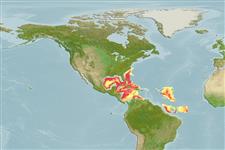Élasmobranches (requins et raies) (sharks and rays) >
Rajiformes (Skates and rays) >
Gurgesiellidae (Pygmy skates)
Etymology: Fenestraja: Latin, fenestra, -ae = small hole or opening in a bone + Latin, raja, -ae = a fish, Raja sp. (Ref. 45335).
Environment: milieu / climate zone / depth range / distribution range
Écologie
marin bathydémersal. Deep-water
Western Central Atlantic: Bahamas and the Florida Keys.
Taille / Poids / Âge
Maturity: Lm ? range ? - ? cm
Max length : 22.0 cm TL (female)
Tail posterior to the tips of the pelvic fins. Prickles on disc and tail are not densely pigmented. Dark marking on disc and tail. Upper surface of disc pale brown. Lower surface pale yellowish without dark markings (Ref. 6902).
Solitary (Ref. 26340). Oviparous (Ref. 50449). Eggs have horn-like projections on the shell (Ref. 205).
Life cycle and mating behavior
Maturité | Reproduction | Frai | Œufs | Fécondité | Larves
Oviparous, paired eggs are laid. Embryos feed solely on yolk (Ref. 50449).
McEachran, J.D. and K.A. Dunn, 1998. Phylogenetic analysis of skates, a morphologically conservative clade of elasmobranchs (Chondrichthyes: Rajidae). Copeia 1998(2):271-290. (Ref. 27314)
Statut dans la liste rouge de l'IUCN (Ref. 130435: Version 2024-1)
Menace pour l'homme
Harmless
Utilisations par l'homme
Outils
Articles particuliers
Télécharger en XML
Sources Internet
Estimates based on models
Preferred temperature (Ref.
123201): 4.1 - 8.8, mean 4.7 °C (based on 200 cells).
Phylogenetic diversity index (Ref.
82804): PD
50 = 0.5039 [Uniqueness, from 0.5 = low to 2.0 = high].
Bayesian length-weight: a=0.00661 (0.00222 - 0.01969), b=2.95 (2.71 - 3.19), in cm total length, based on LWR estimates for this (Sub)family-body shape (Ref.
93245).
Niveau trophique (Ref.
69278): 3.7 ±0.5 se; based on size and trophs of closest relatives
Résilience (Ref.
120179): Faible, temps minimum de doublement de population : 4,5 à 14 années (Fec assumed to be <100).
Fishing Vulnerability (Ref.
59153): Low vulnerability (12 of 100).
